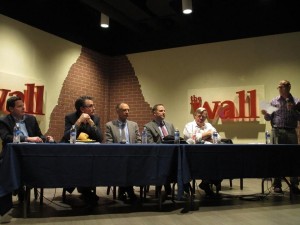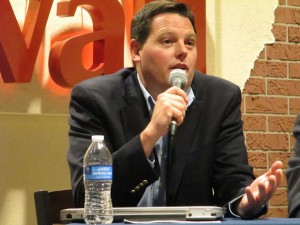Dr. Geoff Silcox joined the panel at an air quality discussion at The Wall at Brigham Young University.
Most members of the BYU community generally don’t think twice about the air they breathe everyday, but this was the topic of a discussion hosted at The Wall on Thursday night.
The BYU Environmental Science Club brought in five professionals from all different backgrounds for the discussion. Students, faculty and members of the community filled The Wall to ask questions and gather advice from these professionals. Panelists included Arden Pope, professor of economics; Jaron Hansen, professor of chemistry and biochemistry; Bryce Bird, director of air programs at the Utah Department of Environmental Quality; Larry St. Clair, professor of biology; and Geof Silcox, professor of chemical engineering at the University of Utah.
Panelists discuss important issues related to Utah’s air quality. (Photo courtesy BYU Environmental Science Club)
Panelists explained that Utah’s air quality today is actually significantly better than it has been in the past.
“By all measures, pollution should be getting worse,” Hansen said. “Compared to the 1970′s, our gross domestic product is up by about 200%; vehicle miles traveled is up by 120 percent. But with all of these things going against us, air pollution is getting better. The air is cleaner now than it was 10 years ago, and it’s much cleaner than it was 20 or 30 years ago. It’s because of good researchers, like the ones we have here today, and good policies, that our air quality is getting better.”
However, panelists explained that there is still room for improvement in Utah’s air quality. The main sources of Utah’s air pollution are motor vehicles and wood-burning stoves, Hansen said. The months from December to February bring the worst air for Utah because of inversions trapping in the air, added Pope. This bad air will affect people by causing respiratory problems, such as coughing and colds or, in more severe cases, heart attacks.
“During the winters when Utah Lake freezes, Utah’s air quality is twice as bad,” said Bird. “Having that large, flat, reflective surface makes air quality worse.”
As a representative from the Utah Department of Environmental Quality, Bird explained that Utah has a brand new air quality app that citizens can download to check local air quality daily. He also said Utah is also in the process of coming up with plans to improve the air. A major focus of one of these plans is to work with manufacturers to reduce the volatile organic compounds found in items such as nail polish remover and aerosols.
Prof. Jaron Hansen explained to students how to make a difference in air quality. (Photo courtesy BYU Environmental Science Club)
“But there are simple things we can all do as individuals as well,” Silcox added. “If you have to run errands, plan your routes efficiently. If you hang up your clothes to dry instead of using a dryer, you’re reducing energy use as well.”
Professor Hansen said the quality of future air is in the hands of current students.
“We we need you — bright engineers, bright chemists, bright environmental management majors — to think of how to reduce emissions,” Hansen said. “It takes creativity and inspiration. I think the Lord wants us to succeed at this, but it requires you all to combine efforts and come up with inspired technology to combat bad air quality.”
– See more at: http://universe.byu.edu/2013/11/22/air-quality-discussion-draws-in-crowd-at-the-wall/#sthash.ODoCAwJq.dpuf

